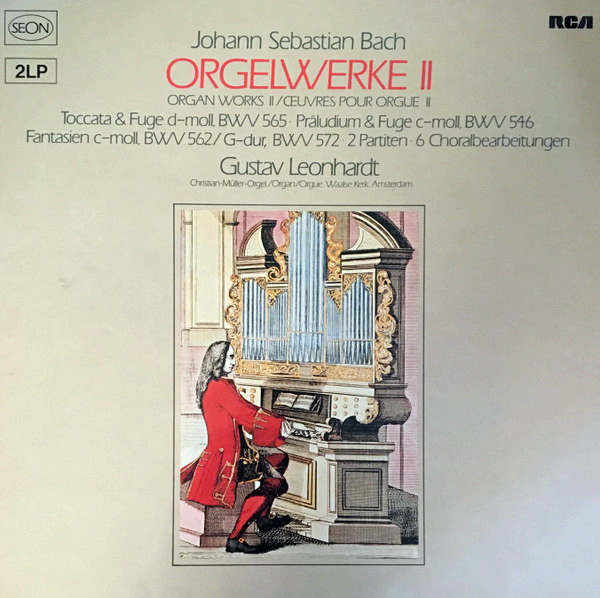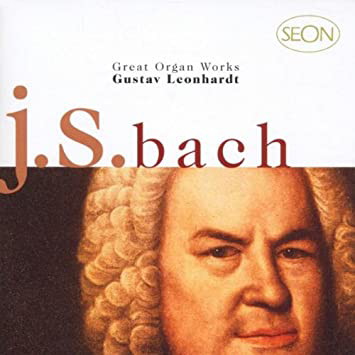 |
2 LPs
- 6775 018 - (p) 1975
|
 |
| 2 LPs -
RL 30428 - (p) 1980 |
 |
| 2 CDs -
SB2K 63185 - (c) 1997 |
|
ORGELWERKE II
|
|
|
|
|
|
|
|
| Johann Sebastian
BACH (1685-1750) |
Toccata
and Fugue in D Minor, BWV 565 |
|
7' 18" |
A1 |
|
Fantasia
in C Minor, BWV 562 |
|
5' 16" |
A2
|
|
Fantasia in G Major, BWV 572
|
|
10' 11" |
A3
|
|
Partite
diverse sopra "O Gott, du frommer Gott",
BWV 767
|
|
17' 54" |
B1 |
|
Chorale
Prelude "Valet will ich dir Geben",
BWV 736 |
|
4' 44" |
B2 |
|
Prelude
and Fugue in C Minor, BWV 546 |
|
12' 59" |
C1 |
|
Chorale
"Allein Gott in der Höh'", BWV 663 |
|
8' 30" |
C2 |
|
Chorale
"O Lamm Gottes, unschuldig", BWV 618 |
|
4' 20" |
C3 |
|
Chorale
Prelude "Jesus Christus, unser
Heiland", BWV 665 |
|
4' 55" |
D1 |
|
Chorale
Prelude "Jesus Christus, unser Heiland",
BWV 666 |
|
3' 10" |
D2 |
|
Chorale
Prelude "Wir Christenleut' hab'n jetzund
Freud", BWV 710 |
|
2' 22" |
D3 |
|
Partite
diverse sopra "Christ, der du bist der
helle Tag", BWV 766 |
|
10' 37" |
D4 |
|
|
|
|
|
| Gustav
Leonhardt, at the Christiaan Müller
Organ of the "Waalse Kerk" Amsterdam,
built 1733/34 |
|
|
|
|
|
Luogo
e data di registrazione |
|
Marzo 1973
|
|
|
Registrazione: live
/ studio |
|
studio |
|
|
Producer /
Recording Supervisor |
|
Wolf Erichson
|
|
|
Recording Engineer
|
|
Dieter Thomsen
|
|
|
Prima Edizione LP |
|
Seon (Philips) | 6775
018 | 2 LPs - durata 45' 23" - 46'
53" | (p) 1975 | ANA
Seon (RCA Red Seal) | RL 30428 | 2
LPs - durata 45' 23" - 46' 53" |
(p) 1980 | ANA
|
|
|
Edizione CD |
|
Sony | SB2K 63185 | 2
CDs - durata 70' 11" - 77' 34" |
(c) 1997 | ADD
|
|
|
Original Cover
|
|
Christoph Weigel
(1654-1725) - Organist kupferstich
aus "Theatrum Musicum", Nürnberg,
1720
|
|
|
Note |
|
Il doppio CD Sony
contiene anche brani di altra
pubblicazione (Seon 6775 001).
|
|
|
|
|
Compared with
many other musical giants of
history Johann Sebastian
Bach was a ,,late
developer”. He matured
slowly, but steadily. It was
not until he was between 25
and 30 years of age, i. e.
during the Weimar period,
that he acquired complete
mastery of his art, a
mastery, however, that was
to be maintained
consistently right up to the
end of his life. Although
the process of “finding
himself” was a gradual one,
this does not, of course,
mean that all his early
works can be dismissed as
having little artistic merit
- on the contrary, even they
tower far above anything
similar written by his
contemporaries and provide
ample glimpses of latent
genius. This particularly
applies to his early works
for organ, the instrument
with which he naturally felt
the closest affinity, being
the one in constant daily
use. Here we find
germinating the ideas that
were to come to fruition in
the great masterpieces of
the later years.
One of the most gripping and
most popular of all Bach’s
early works is the famous Toccata
in D minor (BWV 565).
Full of primal energy, the
work sets off in extemporary
manner with powerfully
descending unisoni, broken
chords and chords of the
diminished seventh, until
finally the pedal enters
with impressive solemnity.
The fugue, whose theme has
already been intimated in
the opening Adagio,
temporarily relaxes the
mood, but the dramatic
intensity returns again with
the reappearance of the
toccata section.
The Fantasia in G major
(BWV 572) is a typical
product of the emotionally
exuberant ,,Sturm und Drang”
years. Although actually
divided into three sections
- the young Bach uses French
designations for the
movements: Très vitement,
Grave, Lentement - the work
gives the impression of
being one long ecstasy of
sound and colour. In the
third section, hidden
beneath the glittering array
of broken chords, is some
genuine fivepart
counterpoint which subtly
refers back to various
elements in the preceding
sections. Most compelling is
the extensive Grave middle
section with its weighty
appoggiaturas, diminished
chords and sweeping melodic
curves. The effect created
by the bass ascending in
semibreves diatonically over
two octaves is quite
monumental in its grandeur.
The two C minor works are
products of Bach’s mature
years. The Fantasia BWV
562 (there is a fugue
belonging to it, which is
unfortunately unfinished) is
an unusually expressive
compositon developed out of
a single musical idea. Two
pedal points at the begin
ning and at the end of the
work form an effective
frame. The opening movement
of the Prelude and Fugue
in C minor (BWV 546)
is likewise very clear in
its construction. A work of
mighty proportions it serves
to depict strong, passionate
emotion. After the initial
powerful pedal point come
motives familiar to us from
the final chorale of Part I
of the ,,Matthew Passion”
and other works. At the
first climax Bach already
uses the chord of the
Neapolitan sixth, with Bach
always a sign of the
exceptional. The episode
employs a double theme which
substantially determines the
musical course of events
right up to the close of the
movement. The following
fivepart fugue is based on
two themes: an evenly
constructed, solemnly
striding theme and a more
mobile one, of which, for
the most part, only the
opening is developed,
however. The tremendous
build-up on the dominant
just before the pedal enters
for the last time is a most
impressive preparation for
the coda.
The chorale partitas
are some of Bach’s very
earliest pieces and, unlike
other of his youthful works,
can be dated with certainty
“c.1700” (although they were
most probably revised
later). The influence of
Georg Böhm is very apparent.
In the partitas Bach applies
the techniques of the
secular song-and-variation
form to the chorale.
Although each “partita”, i.
e. variation, is supposed to
correspond to the text of
one of the verses (quoted
before it), the influence of
the text on the music is, at
this stage, not always very
great. In O Gott, du
frommer Gott (BWV 767)
the concept of death in the
8th partita inspires Bach to
treat the material in an
expressive chromatic manner.
The subject of death was,
incidentally, throughout his
life the inspiration of some
of his finest music. In the
extended final partita, no.
9, he uses a fanfare motive
to illustrate the
“resurrection of the dead”.
The choral partita Christ,
der dn bist der helle Tag
(BWV 766) is extremely sweet
and gentle in character, at
times almost sentimental.
There is much figurative and
metaphoric treatment, the
young composer often
displaying a naive pleasure
in the pictorial. The warm,
intimate tone of no. 2 is
closely related to the text:
“Lord, keep us safe this
night, we pray”; the triplet
movement in no. 6 depicts
the descending and ascending
of the angels, and the
dropping, closing together
motives in no. 7 suggest the
“shutting eyelids”.
In Bach’s chorale preludes,
however, no matter from
which period they come, the
literary text receives a
musical interpretation hard
to surpass. In O Lamm
Gottes unschuldig (BWV
618) from the
“Orgelbüchlein” the cantus
firmus rendered in canon at
the fifth symbolizes the
fulfilment of divine will
through the Son, the oneness
of God the Father and
Christ. The contrastin
“sobbing” motive (cf. BWV
546 above) symbolizes
mourning. Wir
Christenleut’ (BWV
710) is one of Bach’s finest
chorale trios, with much
imitative work and stretto
treatment of the melody. In
Valet will ich dir geben
(BWV 736) the proud,
masculine tune appears in
the bass. To symbolize the
triumph over death Bach uses
nimble upbeat figures with
leaps to the fourth and
fifth, figures which bound
with even more enthusiasm in
the third line. Clearly an
early work, Allein Gott
in der Höh' sei ehr'
(BWV 663) presents the
imaginatively ornamented
cantus firmus in the tenor,
in the manner of the
traditional North German
chorale fantasia. In Jesu
Christus, unser Heiland
(BWV 665), based on the
Lutheran communion hymn, the
text is reflected in great
detail. The continually
upward-striving counterpoint
of the first line is
obviously meant to represent
the soul’s striving to reach
its Savior, the syncopations
of the second line the
struggle for God’s love. The
“bitter suffering” of the
third line is symbolized by
agonising chromatic
descents, the “torments of
hell” of the fourth by the
upwardrushing
demisemiquavers. The chorale
prelude BWV 666 based on the
same hymn tune is unique in
that it employs the manuals
almost exclusively (only at
the end a pedal note is used
for support). On the whole
this version is much more
neutral. The someWhat
rapturous style of the close
suggests that it is an early
work.
Lothar
Hoffmann-Erbrecht
English
translation by Avril Watts
|
  |
|
|